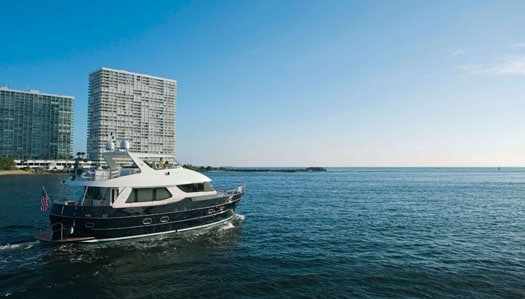
ytgjan09cheoy68525.jpg
Say the words “double ender” to experienced skippers and, for many, the immediate image is one of those classic sepia photographs by Rosenfeld, featuring a luxury yacht from the Roaring Twenties, where the elliptical shape of the stern was the perfect place to lounge in wicker chairs or host elegant parties. For saltier types, the classic double ender is a redningskoite, the legendary rescue craft of the North Sea that was immensely seaworthy in the worst of conditions.
Cheoy Lee is double-dipping with their double-ended Serenity 68 Long Range Motoryacht-scooping from the classic luxury side while still playing the seaworthiness card.
From a distance, the Serenity 68 is, well, damn pretty. Okay, I admit that I have a fondness for double-ended yachts, but Cheoy Lee has updated those classic lines with a thoroughly modern house that really works. The coachroof around the flying bridge may have the modern “melted cheese” soft lines, but they do nothing to distract from the crisp styling of everything from the raked windscreen to the swept-forward stanchions.
Adding to her seaworthy demeanor is the protective stainless steel plating around the bow anchor hawses that are both beautifully crafted and essential for a cruising yacht. Double-enders have many wonderful features, but they all share one common problem: How do you get aboard? A century ago, the yachts were large enough to have boarding stages amidships for tenders and launches to arrive, not to mention large crews standing by to assist guests.
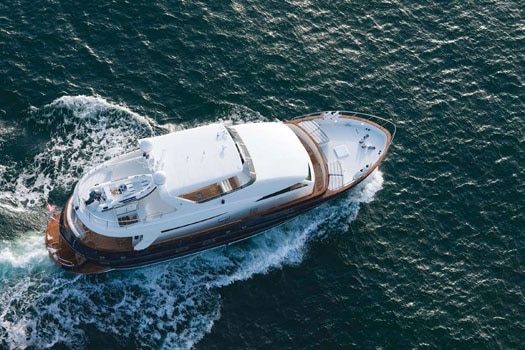
| | |
Conventional yachts usually have a swim platform on the transom, which makes for easy egress from tender or water, and the Cheoy Lee 68 has the perfect resolution: a wraparound teak-grated platform that combines sturdy railings with water-level accessibility. Because the bulwarks have considerable tumblehome above the sheer line, Cheoy Lee came up with a cleverly engineered double-door to close off the transom, as well as gently curving stairs to the after cockpit. It is, in short, a design solution as elegant as the fantail transom itself.
Once aboard, the cockpit is so comfortably arranged that you are tempted to stop here to enjoy the high-backed and curving settee that wraps around a lovely example of Cheoy Lee craftsmanship: an inlaid teak table. Protected by wing doors and easily enclosed for allweather enjoyment, the area also has a marble-topped wet bar and several easily stored teak director’s chairs. But this is just a prelude to the interior of the Serenity 68.
Though the yacht has wide (and deeply bulwarked) side decks, there is no sense of diminished space in the salon, which has an interestingly functional design. Rather than separate the dining area forward, as on many yachts, the dining table is offset to starboard, opening up the salon all the way to the intricately inlaid forward bulkhead. It allows for six guests to sit comfortably and, with a passthrough from the galley, service is simplified as well.
The décor on this Serenity 68 was done by Sylvia Bolton Design. This was a spec boat aimed at a boat-show debut, so you wouldn’t expect anything so wild as to discourage potential customers. What Bolton created, however, is a warm and inviting interior that makes the most of the skills of Cheoy Lee’s craftsmen, with sumptuous teak paneling, inlaid tables, and comfortable loose furniture. Woven wall coverings add a pleasant texture, and are repeated in different themes throughout the yacht.
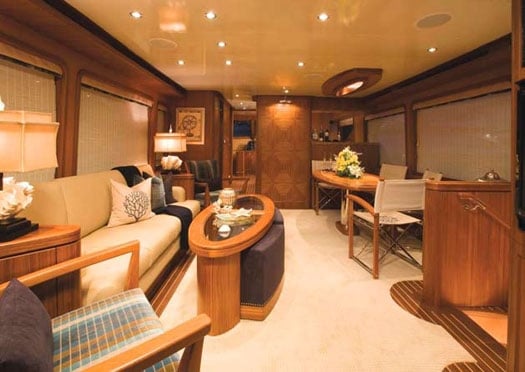
| | |
The port side of the salon has another thoughtful design: Rather than the usual square end-tables by the settee, these are triangular so the loose chairs can face inwards as a conversation area or for viewing the large-screen Sharp TV in the after corner. A pair of hassocks hide under the coffee table for occasional seating.
The galley is just forward, with wraparound granite counters, a huge Sub-Zero fridge with freezer drawers and a teak and holly sole for easy cleaning. A four-burner GE Profile cooktop is on the forward counter, large double sinks are outboard, and the backsplashes are finished in mosaic tiles. There are thoughtful touches, too, such as self-closing drawers and plenty of stowage above and below the counters. Opposite the galley is a comfortably sized day-head with a space-saving bi-fold door, tiled sole, and trendy bowl sink.
The pilothouse is clearly designed for voyaging, with a pocket door that can close it off from the lights and distractions of the salon and galley at night. This is truly the skipper’s “office,” from the large chart table with chart-storage drawers starboard of the centerline helm, to the beautifully finished but husky pantograph doors on each side that are sturdy enough to withstand conditions I don’t ever want to encounter.
The helm is designed for easy scanning, with twin KEP monitors, the Caterpillar digital engine gauges, and a Stidd helm chair. The starboard corner of the pilothouse has a large raised settee behind another beautiful inlaid table. From a service standpoint, there is a crawl space under the entire dash, giving complete access to the electronics and leaving room for black-box installations as well.
Step through the side doors and you’re on the teak-capped Portuguese bridge. It’s really a continuation of the side decks, so short-handed cruisers can move easily around the entire yacht in any weather with the protection of the bridge overhang. An opening section forward leads to the foredeck, with twin benches on either side and a pair of burly Maxwell 4000 windlasses in the bow. Sizable bulwarks are topped by stainless steel welded rails for added security, and incorporate fender racks as well.
The flying bridge is another example of thoughtful planning. Access is from an interior stairwell in the pilothouse or from a stainless steel ladder on the afterdeck, and both are comfortably sized, with safety rails.
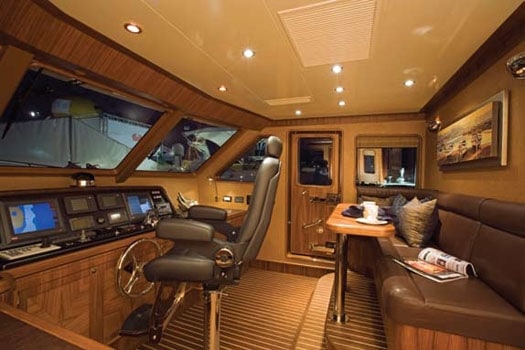
| | |
The helm is a simple fiberglass console with duplicates of the monitors and controls in the pilothouse. A Stidd chair and built-in double seat provide a fine view over the bow, and there is a large flat space for charts to starboard, plus recessed trays for all the stuff you need: sunglasses, cruising guides, binoculars, and more.
Abaft the helm is an L-shaped settee and another teak table accented with mother-of-pearl inlays. The starboard side of the bridge is taken up by what can only be called an outdoor kitchen. This isn’t the usual mini-wet bar, but a marble-topped cooking area with a Jenn-Air four-burner grill under a hinged cover, a large sink, and undercounter fridge with icemaker.
A beautifully finished fiberglass hardtop protects this area, and incorporates an electronics arch for satcom domes, plus radar. A tinted venturi windscreen around the entire entertaining area provides good wind protection but this would also be an easy bridge to enclose.
The boat deck is ballroom-sized, since it extends over the side decks to utilize the full beam. It’s surrounded by a very solid waist-high double stainless steel rail, with gates to allow the tender to be launched. A 1,500-pound Nautical Structures davit makes easy work of the 13 ½-foot Nautica RIB with a 40-horse Yamaha outboard.
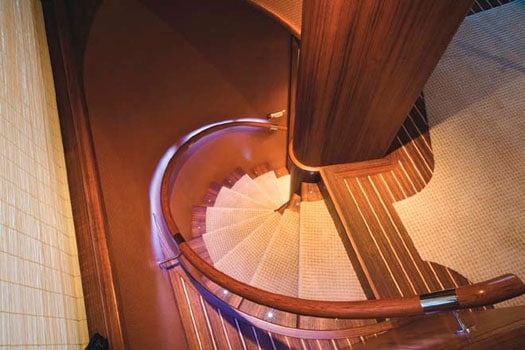
| | |
A curving stairwell from the salon leads to the primary staterooms, with the owner’s suite taking the premium spot just aft of amidships, where motion will be the least felt. The foyer is accented by, no surprise, a beautifully inlaid teak sole, and I particularly liked the hidden light ropes in the stairwell railing that provide a gentle glow at night.
The owner of the Serenity 68 lives in grand style, with a king-sized berth under a teak overhead treatment that gives, at first glance, the effect of a shortened four-poster bed. Teak inlays cover the bulkhead above the padded headboard, and the cabin is finished in teak and soothing fabrics. To starboard is a love seat that, for once, actually beckons for quiet time spent with a book. The opposite side has a bureau with drawers and lockers. One touch I particularly liked was the white-planked ceiling on each side of the cabin, which sets off the polished stainless ports and provides a salty reminder that you are actually on a yacht.
The master head is just forward, with twin bowl sinks and a tiled backsplash. There is a large spa bathtub and shower combination.
The VIP stateroom is aft and, at first glance, a bit confusing because it tapers inward like the bow. But wait! This is a double ender…it tapers at both ends! The double berth is surrounded by planked white ceilings and set on a beautifully crafted teak base with storage drawers. Guests have good stowage, and a pleasantly large ensuite head with shower.
Another stairwell leads from the pilothouse to the forward cabins. A second VIP cabin is in the bows (and this time the tapering hull sides make sense). All the amenities of the other cabins are duplicated, with white-planked ceilings, large hanging lockers, and a private head with oversized shower.
A crew cabin is just aft but since the owner and his party could easily handle the Serenity 68, this cabin could be used for kids and is finished to the same standards as the rest of the yacht. A nice touch, especially if used by a captain, is the private head with another large shower.
Thoughtfully close to the crew cabin and just down the steps from the pilothouse, the full-sized water-tight door to the engineroom is a civilized way to take care of service and maintenance. There is full headroom in the engineroom and Cheoy Lee has taken a page from their commercial shipping history to make this an engineer’s dream. Diamondplate covers the floor, the bilge is finished to perfection, and everything is easily accessible. The fuel manifold system is clearly marked and intuitively designed, fuel filters are presented at waist height on one end of the centerline workbench (complete with sink), and racks above the twin 315-horsepower Caterpillar C7 diesels use otherwise empty air space to hold the Glendinning cable reel and the air conditioning compressors. The fuel tanks are outboard and have huge clean-out panels for servicing. On either side are Kohler 20 kW generators in fiberglass sound shields and the main engines lie flat amidships.
Standard equipment on the Serenity 68 is both extensive and thoughtful, including Naiad 254 stabilizers, a Sidepower bow thruster, a 15 kVA isolation transformer for shore power, and a full touchscreen monitoring system.
Having done a 200-mile passage aboard a sistership in what might best be called “ugly weather,” I can vouch for the Serenity 68 in offshore conditions. She has an easy motion, slips along without effort, and tracks like a freight train in all sea directions. Our test boat topped out at 11.5 knots and, with 2,350 gallons of fuel available, has a range of almost 2,000 nm at about 8 knots, or 1,500 miles at 9 knots.
But, with a yacht this beautifully designed and finished, you’ll want to take your time getting there.
Cheoy Lee Shipyards North America, (954) 527-0999; www.cheoyleena.com









